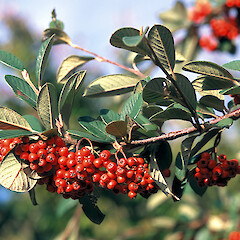Cotoneaster coriaceus
Common name
cotoneaster
Synonyms
Cotoneaster lacteus W.W.Sm
Family
Rosaceae
Flora category
Vascular – Exotic
Structural class
Trees & Shrubs - Dicotyledons
NVS code
The National Vegetation Survey (NVS) Databank is a physical archive and electronic databank containing records of over 94,000 vegetation survey plots - including data from over 19,000 permanent plots. NVS maintains a standard set of species code abbreviations that correspond to standard scientific plant names from the Ngä Tipu o Aotearoa - New Zealand Plants database.
COTLAC
Conservation status
Not applicable
Habitat
Dry shrubland, forest margins, wasteland in urban places.
Detailed description
Spreading evergreen shrub up to 3 m high. Young shoots buff tomentose and erect, later becoming glabrous, dark purplish and arching. Leaves up to 80m x 45 mm, slightly shining and with deeply impressed veins above, tomentose beneath, becoming less so with age. Flowers in clusters of 20-80, with spreading white petals. Fruit 5-8 mm diameter, glossy orange of scarlet red.
Manaaki Whenua Online Interactive Key
Similar taxa
Generally similar to C. glaucophyllus but leaves with veins strongly impressed above. and more flowers in each cluster.
Flowering
November, December, January
Flower colours
White
Fruiting
February-August.
Year naturalised
1988
Origin
Yunnan (China)
Etymology
cotoneaster: From cotoneus an old Latin name for the quince, and possibly aster, corruption of adinstar ‘resembling’, i.e. quince-like
Reproduction
Reproduces from seed.
Seed
Many seeds are produced per fruit, but viability is unknown at this stage.
Dispersal
Seed is widely distributed by birds.
Tolerances
Tolerant of wet-dry.
References and further reading
Dickore WB, Kasperek G. 2010: Species of Cotoneaster (Rosaceae, Maloideae) indigenous to, naturalising or commonly cultivated in Central Europe. Willdenowia 40(2): 13-45.





